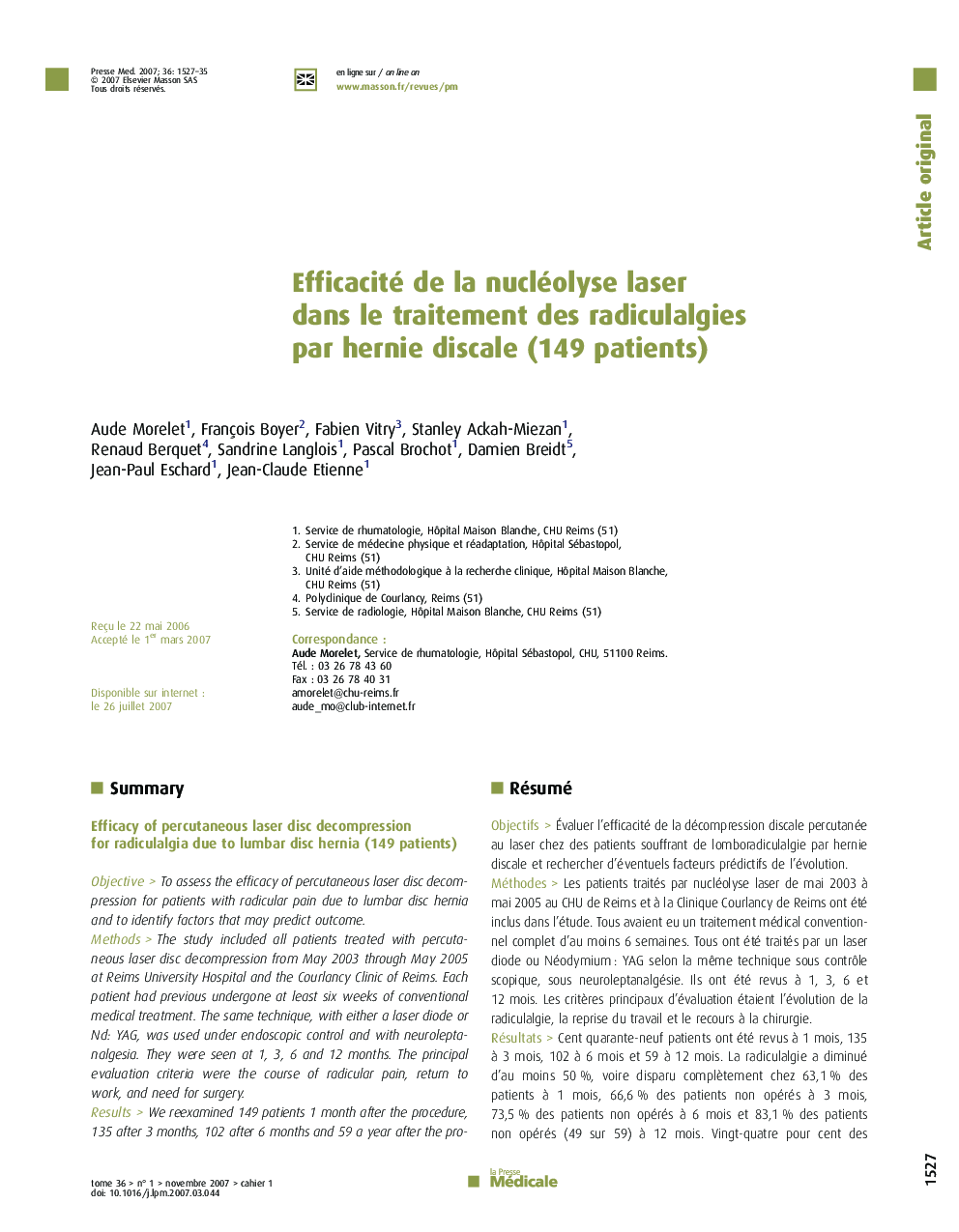| کد مقاله | کد نشریه | سال انتشار | مقاله انگلیسی | نسخه تمام متن |
|---|---|---|---|---|
| 3820115 | 1246474 | 2007 | 9 صفحه PDF | دانلود رایگان |

SummaryObjectiveTo assess the efficacy of percutaneous laser disc decompression for patients with radicular pain due to lumbar disc hernia and to identify factors that may predict outcome.MethodsThe study included all patients treated with percutaneous laser disc decompression from May 2003 through May 2005 at Reims University Hospital and the Courlancy Clinic of Reims. Each patient had previous undergone at least six weeks of conventional medical treatment. The same technique, with either a laser diode or Nd: YAG, was used under endoscopic control and with neuroleptanalgesia. They were seen at 1, 3, 6 and 12 months. The principal evaluation criteria were the course of radicular pain, return to work, and need for surgery.ResultsWe reexamined 149 patients 1 month after the procedure, 135 after 3 months, 102 after 6 months and 59 a year after the procedure. At a month after surgery, radicular pain had decreased by at least half, and sometimes even completely disappeared in 63.1% of patients at 1 month, 66.6% at 3 months, 73.5% at 6 months, and 83.1% at 12 months, while 24%, 50,4%, 61.2%, and 67.3%, respectively, had returned to work. No patient had serious complications. Finally, 45 of the 149 (30.2%) patients chose to have a traditional surgical procedure after percutaneous laser disc decompression.ConclusionPercutaneous laser disc decompression is effective, noninvasive and well tolerated for patients with radicular pain due to lumbar disc hernia.
RésuméObjectifsÉvaluer l'efficacité de la décompression discale percutanée au laser chez des patients souffrant de lomboradiculalgie par hernie discale et rechercher d'éventuels facteurs prédictifs de l'évolution.MéthodesLes patients traités par nucléolyse laser de mai 2003 à mai 2005 au CHU de Reims et à la Clinique Courlancy de Reims ont été inclus dans l'étude. Tous avaient eu un traitement médical conventionnel complet d'au moins 6 semaines. Tous ont été traités par un laser diode ou Néodymium : YAG selon la même technique sous contrôle scopique, sous neuroleptanalgésie. Ils ont été revus à 1, 3, 6 et 12 mois. Les critères principaux d'évaluation étaient l'évolution de la radiculalgie, la reprise du travail et le recours à la chirurgie.RésultatsCent quarante-neuf patients ont été revus à 1 mois, 135 à 3 mois, 102 à 6 mois et 59 à 12 mois. La radiculalgie a diminué d'au moins 50 %, voire disparu complètement chez 63,1 % des patients à 1 mois, 66,6 % des patients non opérés à 3 mois, 73,5 % des patients non opérés à 6 mois et 83,1 % des patients non opérés (49 sur 59) à 12 mois. Vingt-quatre pour cent des patients ont repris leur travail à 1 mois, 50,4 % à 3 mois, 61,2 % à 6 mois et 67,3 % (37 sur 55) à 12 mois. Aucun patient n'a eu de complication grave. Au total, 45 patients sur 149, soit 30,2 %, ont été opérés après nucléolyse laser.ConclusionLa nucléolyse laser est une technique efficace, peu invasive, bien tolérée chez les patients souffrant d'une lomboradiculalgie par hernie discale.
Journal: La Presse Médicale - Volume 36, Issue 11, Part 1, November 2007, Pages 1527–1535